Assessment of Aquatic Reed Stands from Airborne Photogrammetric 3K Data
Abstract
:1. Introduction
2. Materials and Methods
2.1. Study Area
2.2. Field Data Collection
2.3. K System and Data Set
2.4. Photogrammetric Processing Chain
2.5. Derivation of Aquatic Reed Status Diagnostic Parameters
2.5.1. Aquatic Reed Stand Height
2.5.2. Reed Extent
2.5.3. Aquatic Reed Density
2.5.4. Aquatic Reed Stand Frontline Geometries
2.5.5. Aquatic Reed Status Estimation Derived by a Combinatorial Approach
2.6. Assessment of Reed Metrics Accuracies
3. Results
3.1. Aquatic Reed Heights Determination
3.2. Aquatic Reed Extent
3.3. Aquatic Reed Density
3.4. Status Estimation through Frontline Geometries
3.5. Aquatic Reed Status Estimation Derived by a Combinatorial Approach
4. Discussion
4.1. Aquatic Reed Heights
4.2. Reed Extent
4.3. Aquatic Reed Density
4.4. Status Estimation through Frontline Geometries
4.5. Aquatic Reed Status Estimation Derived by a Combinatorial Approach
5. Conclusions
Author Contributions
Funding
Informed Consent Statement
Data Availability Statement
Acknowledgments
Conflicts of Interest
References
- Gigante, D.; Venanzoni, R.; Zuccarello, V. Reed Die-Back in Southern Europe? A Case Study from Central Italy. Comptes Rendus Biol. 2011, 334, 327–336. [Google Scholar] [CrossRef]
- Grosser, S.; Melzer, A.; Pohl, W. Untersuchung des Schilfrückgangs an Bayerischen Seen: Forschungsprojekt des Bayerischen Staatsministeriums für Landesentwicklung und Umweltfragen; Bayerisches Landesamt für Umweltschutz: Wielenbach, Germany, 1997. [Google Scholar]
- Krumscheid, P.; Stark, H.; Peintinger, M. Decline of Reed at Lake Constance (Obersee) Since 1967 Based on Interpretations of Aerial Photographs. Aquat. Bot. 1989, 35, 57–62. [Google Scholar] [CrossRef]
- Ostendorp, W. “Die-Back” of Reeds in Europe: A Critical Review of Literature. Aquat. Bot. 1989, 35, 5–26. [Google Scholar] [CrossRef] [Green Version]
- Rücker, A.; Grosser, S.; Melzer, A. Geschichte und Ursachen des Röhrichtrückgangs Am Ammersee (Deutschland). Limnol.—Ecol. Manag. Inland Waters 1999, 29, 11–20. [Google Scholar] [CrossRef] [Green Version]
- van der Putten, W.H. Die-Back of Phragmites Australis in European Wetlands: An Overview of the European Research Programme on Reed Die-Back and Progression (1993–1994). Aquat. Bot. 1997, 59, 263–275. [Google Scholar] [CrossRef]
- Ostendorp, W.; Dienst, M.; Schmieder, K. Disturbance and Rehabilitation of Lakeside Phragmites Reeds Following an Extreme Flood in Lake Constance (Germany). Hydrobiologia 2003, 506–509, 687–695. [Google Scholar] [CrossRef] [Green Version]
- Schmieder, K.; Dienst, M.; Ostendorp, W.; Jöhnk, K.D. Effects of Water Level Variations on the Dynamics of the Reed Belts of Lake Constance. Int. J. Ecohydrol. Hydrobiol. 2004, 4, 469–480. [Google Scholar]
- Melzer, A.; Harlacher, R.; Held, K.; Sirch, R.; Vogt, E. Die Makrophytenvegetation des Chiemsees; Bayerisches Landesamt für Wasserwirtschaft: Munich, Germany, 1986. [Google Scholar]
- Sukopp, H. Conservation of Wetlands in Central Europe. Available online: https://eurekamag.com/research/026/316/026316883.php (accessed on 17 May 2017).
- Dienst, M.; Schmieder, K.; Ostendorp, W. Dynamik der Schilfröhrichte am Bodensee unter dem Einfluss von Wasserstandsvariationen. Eff. Water Level Var. Dyn. Reed Belts Lake Constance 2004, 34, 29–36. [Google Scholar] [CrossRef] [Green Version]
- LfU, Referat 51 Kartieranleitung Biotopkartierung Bayern (Inkl. Kartierung Der Offenland-Lebensraumtypen Der Fauna-Flora-Habitat-Richtlinie)—Teil 1—Arbeitsmethodik 2018. Available online: https://www.lfu.bayern.de/natur/doc/kartieranleitungen/arbeitsmethodik_teil1.pdf (accessed on 10 January 2022).
- Hoffmann, F.; Zimmermann, S. Chiemsee Schilfkataster. 1973, 1979, 1991 und 1998; Limnologische Station der Technischen Universität München: Iffeldorf, Germany, 2000. [Google Scholar]
- Rosso, P.H.; Ustin, S.L.; Hastings, A. Mapping Marshland Vegetation of San Francisco Bay, California, Using Hyperspectral Data. Int. J. Remote Sens. 2005, 26, 5169–5191. [Google Scholar] [CrossRef]
- Andresen, T.; Mott, C.; Zimmermann, S.; Schneider, T.; Melzer, A. Object-Oriented Information Extraction for the Monitoring of Sensitive Aquatic Environments. In Proceedings of the IEEE International Geoscience and Remote Sensing Symposium, Toronto, ON, Canada, 24–28 June 2002; IEEE: Piscataway, NJ, USA, 2002; Volume 5, pp. 3083–3085. [Google Scholar]
- Villa, P.; Laini, A.; Bresciani, M.; Bolpagni, R. A Remote Sensing Approach to Monitor the Conservation Status of Lacustrine Phragmites Australis Beds. Wetl. Ecol. Manag. 2013, 21, 399–416. [Google Scholar] [CrossRef]
- Villa, P.; Bresciani, M.; Braga, F.; Bolpagni, R. Comparative Assessment of Broadband Vegetation Indices Over Aquatic Vegetation. IEEE J. Sel. Top. Appl. Earth Obs. Remote Sens. 2014, 7, 3117–3127. [Google Scholar] [CrossRef]
- Villa, P.; Bresciani, M.; Bolpagni, R.; Pinardi, M.; Giardino, C. A Rule-Based Approach for Mapping Macrophyte Communities Using Multi-Temporal Aquatic Vegetation Indices. Remote Sens. Environ. 2015, 171, 218–233. [Google Scholar] [CrossRef] [Green Version]
- Gilmore, M.S.; Wilson, E.H.; Barrett, N.; Civco, D.L.; Prisloe, S.; Hurd, J.D.; Chadwick, C. Integrating Multi-Temporal Spectral and Structural Information to Map Wetland Vegetation in a Lower Connecticut River Tidal Marsh. Remote Sens. Environ. 2008, 112, 4048–4060. [Google Scholar] [CrossRef]
- Samiappan, S.; Turnage, G.; Hathcock, L.A.; Moorhead, R. Mapping of Invasive Phragmites (Common Reed) in Gulf of Mexico Coastal Wetlands Using Multispectral Imagery and Small Unmanned Aerial Systems. Int. J. Remote Sens. 2017, 38, 2861–2882. [Google Scholar] [CrossRef]
- Zlinszky, A.; Mücke, W.; Lehner, H.; Briese, C.; Pfeifer, N. Categorizing Wetland Vegetation by Airborne Laser Scanning on Lake Balaton and Kis-Balaton, Hungary. Remote Sens. 2012, 4, 1617–1650. [Google Scholar] [CrossRef] [Green Version]
- Iglhaut, J.; Cabo, C.; Puliti, S.; Piermattei, L.; O’Connor, J.; Rosette, J. Structure from Motion Photogrammetry in Forestry: A Review. Curr. For. Rep. 2019, 5, 155–168. [Google Scholar] [CrossRef] [Green Version]
- Corti Meneses, N.; Brunner, F.; Baier, S.; Geist, J.; Schneider, T. Quantification of Extent, Density, and Status of Aquatic Reed Beds Using Point Clouds Derived from UAV–RGB Imagery. Remote Sens. 2018, 10, 1869. [Google Scholar] [CrossRef] [Green Version]
- Bendig, J.; Bolten, A.; Bareth, G. UAV-Based Imaging for Multi-Temporal, Very High Resolution Crop Surface Models to Monitor Crop Growth VariabilityMonitoring des Pflanzenwachstums Mit Hilfe Multitemporaler und Hoch Auflösender Oberflächenmodelle von Getreidebeständen Auf Basis von Bildern Aus UAV-Befliegungen. Photogramm. Fernerkund. Geoinf. 2013, 2013, 551–562. [Google Scholar] [CrossRef]
- Geipel, J.; Link, J.; Claupein, W. Combined Spectral and Spatial Modeling of Corn Yield Based on Aerial Images and Crop Surface Models Acquired with an Unmanned Aircraft System. Remote Sens. 2014, 6, 10335–10355. [Google Scholar] [CrossRef] [Green Version]
- Wachholz De Souza, C.H.; Camargo Lamparelli, R.A.; Rocha, J.V.; Graziano Magalhães, P.S. Height Estimation of Sugarcane Using an Unmanned Aerial System (UAS) Based on Structure from Motion (SfM) Point Clouds. Int. J. Remote Sens. 2017, 38, 2218–2230. [Google Scholar] [CrossRef]
- Corti Meneses, N.; Baier, S.; Geist, J.; Schneider, T. Evaluation of Green-LiDAR Data for Mapping Extent, Density and Height of Aquatic Reed Beds at Lake Chiemsee, Bavaria—Germany. Remote Sens. 2017, 9, 1308. [Google Scholar] [CrossRef] [Green Version]
- Corti Meneses, N.; Baier, S.; Reidelstürz, P.; Geist, J.; Schneider, T. Modelling Heights of Sparse Aquatic Reed (Phragmites Australis) Using Structure from Motion Point Clouds Derived from Rotary- and Fixed-Wing Unmanned Aerial Vehicle (UAV) Data. Limnologica 2018, 72, 10–21. [Google Scholar] [CrossRef]
- Koma, Z.; Zlinszky, A.; Bekő, L.; Burai, P.; Seijmonsbergen, A.C.; Kissling, W.D. Quantifying 3D Vegetation Structure in Wetlands Using Differently Measured Airborne Laser Scanning Data. Ecol. Indic. 2021, 127, 107752. [Google Scholar] [CrossRef]
- Reinartz, P.; Kurz, F.; Rosenbaum, D.; Leitloff, J.; Palubinskas, G. Image Time Series for Near Real Time Airborne Monitoring of Disaster Situations and Traffic Applications. In Modeling of Optical Airborne and Space Borne Sensors; Copernicus Gesellschaft Mbh: Gottingen, Germany, 2010; Volume 38-1. [Google Scholar]
- Roemer, H.; Kiefl, R.; Henkel, F.; Wenxi, C.; Nippold, R.; Kurz, F.; Kippnich, U. Using Airborne Remote Sensing to Increase Situational Awareness in Civil Protection and Humanitarian Relief—The Importance of User Involvement. In Xxiii Isprs Congress, Commission Viii; Halounova, L., Safar, V., Raju, P.L.N., Planka, L., Zdimal, V., Kumar, T.S., Faruque, F.S., Kerr, Y., Ramasamy, S.M., Comiso, J., et al., Eds.; Copernicus Gesellschaft Mbh: Goettingen, Germany, 2016; Volume 41, pp. 1363–1370. [Google Scholar]
- Thomas, U.; Rosenbaum, D.; Kurz, F.; Suri, S.; Reinartz, P. A New Software/Hardware Architecture for Real Time Image Processing of Wide Area Airborne Camera Images. J. Real-Time Image Proc. 2009, 4, 229. [Google Scholar] [CrossRef]
- Kurz, F. Accuracy Assessment of the DLR 3K Camera System. In Proceedings of the DGPF Tagungsband; Seyfert, E., Ed.; Deutsche Gesellschaft für Photogrammetrie, Fernerkundung und Geoinformation: Jena, Germany, 2009; Volume 18, pp. 1–7. [Google Scholar]
- LfU Bayern Seen in Bayern—LfU Bayern. Available online: https://www.lfu.bayern.de/wasser/seen_in_bayern/index.htm (accessed on 23 May 2017).
- Brocks, S.; Bendig, J.; Bareth, G. Toward an Automated Low-Cost Three-Dimensional Crop Surface Monitoring System Using Oblique Stereo Imagery from Consumer-Grade Smart Cameras. J. Appl. Remote Sens. 2016, 10, 046021. [Google Scholar] [CrossRef] [Green Version]
- Jensen, J.L.R.; Mathews, A.J. Assessment of Image-Based Point Cloud Products to Generate a Bare Earth Surface and Estimate Canopy Heights in a Woodland Ecosystem. Remote Sens. 2016, 8, 50. [Google Scholar] [CrossRef] [Green Version]
- Weiss, M.; Baret, F. Using 3D Point Clouds Derived from UAV RGB Imagery to Describe Vineyard 3D Macro-Structure. Remote Sens. 2017, 9, 111. [Google Scholar] [CrossRef] [Green Version]
- QGIS Development Team. QGIS Geographic Information System. Open Source Geospatial Foundation Project; QGIS Development Team: Chur, Switzerland, 2020. [Google Scholar]
- Kerner, S.; Kaufman, I.; Raizman, Y. Role of Tie-Points Distribution in Aerial Photography. In Eurocow 2016, the European Calibration and Orientation Workshop; Skaloud, J., Colomina, I., Eds.; Copernicus Gesellschaft Mbh: Gottingen, Germany, 2016; Volumes 40–43, pp. 41–44. [Google Scholar]
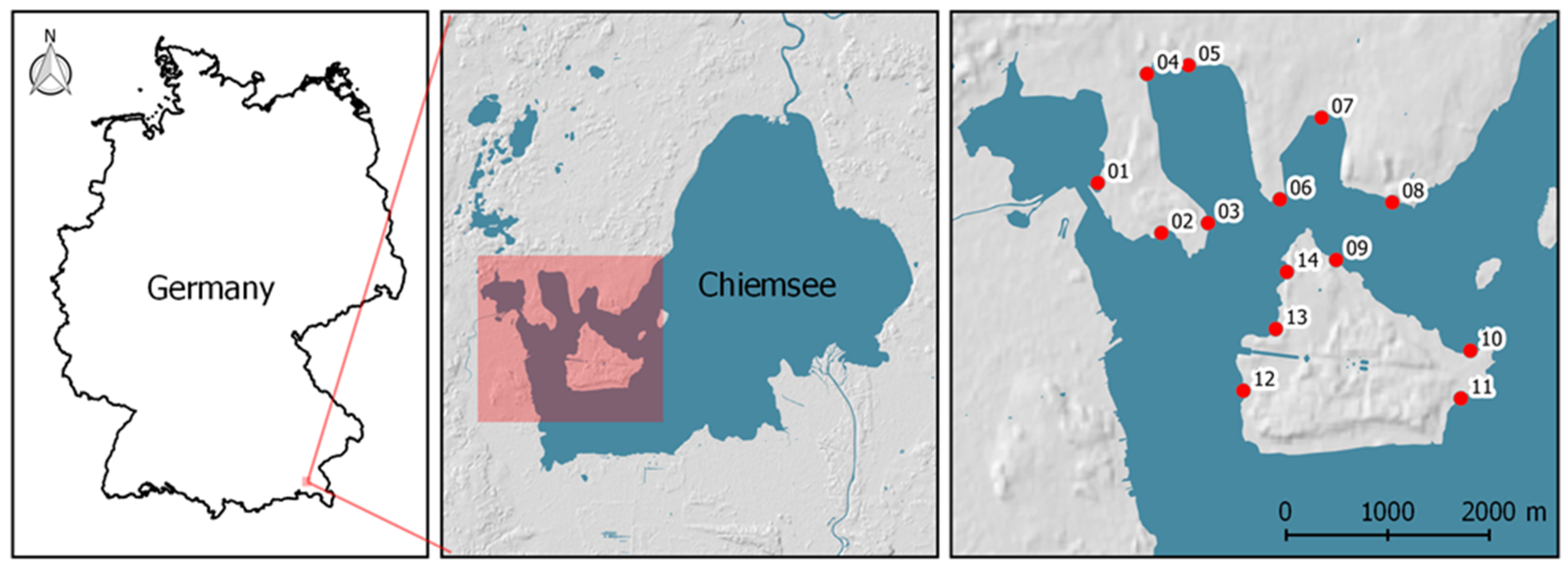
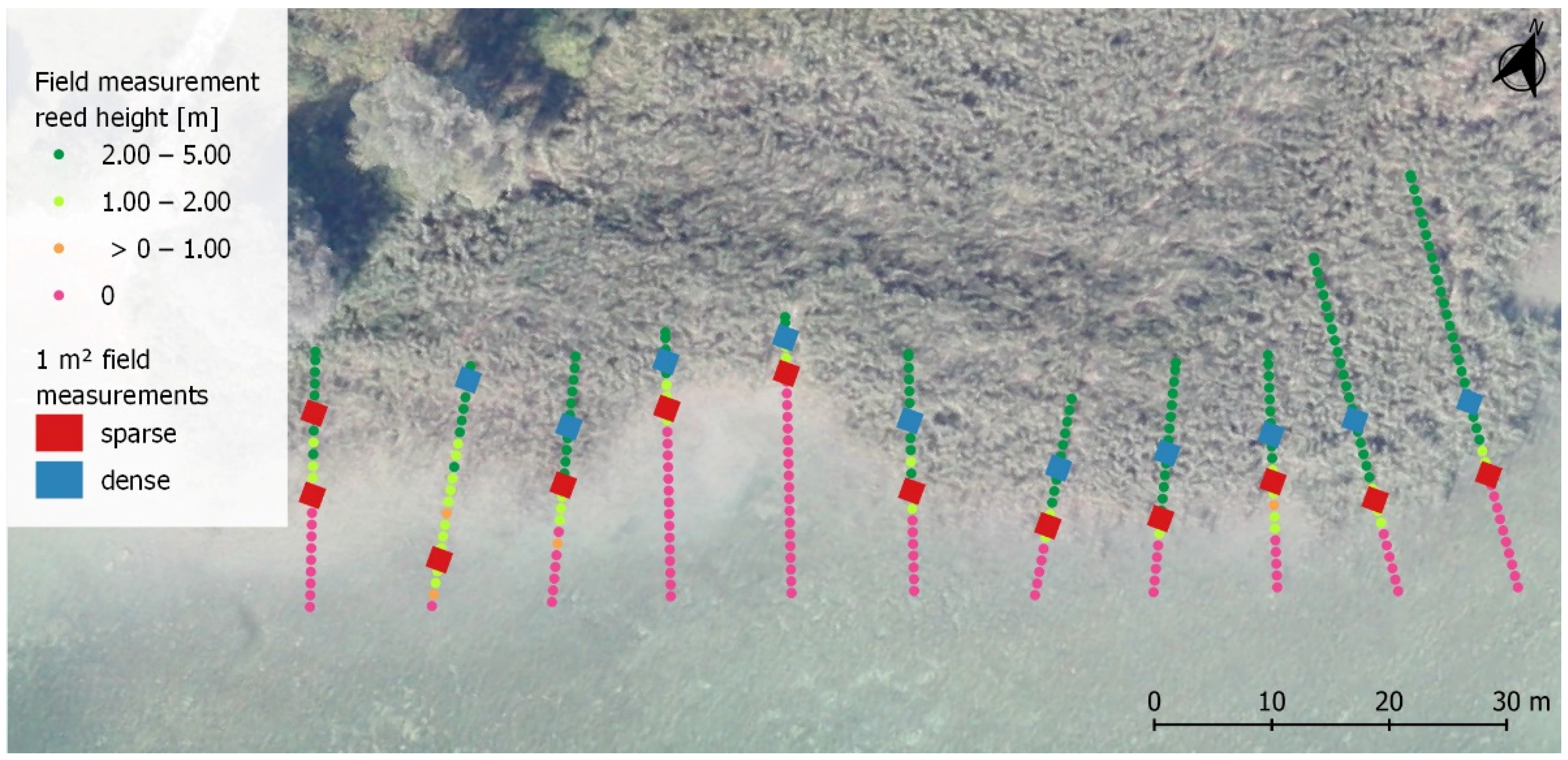
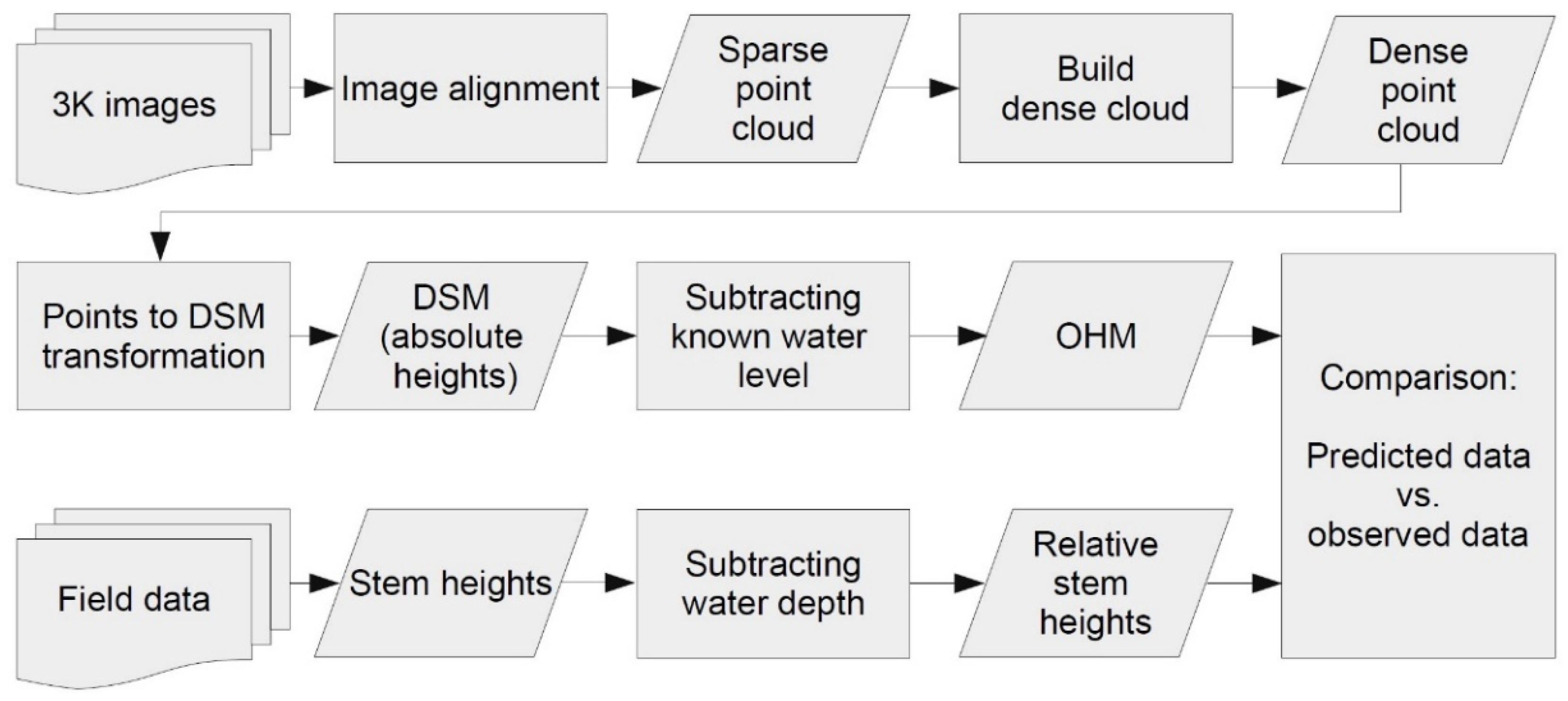
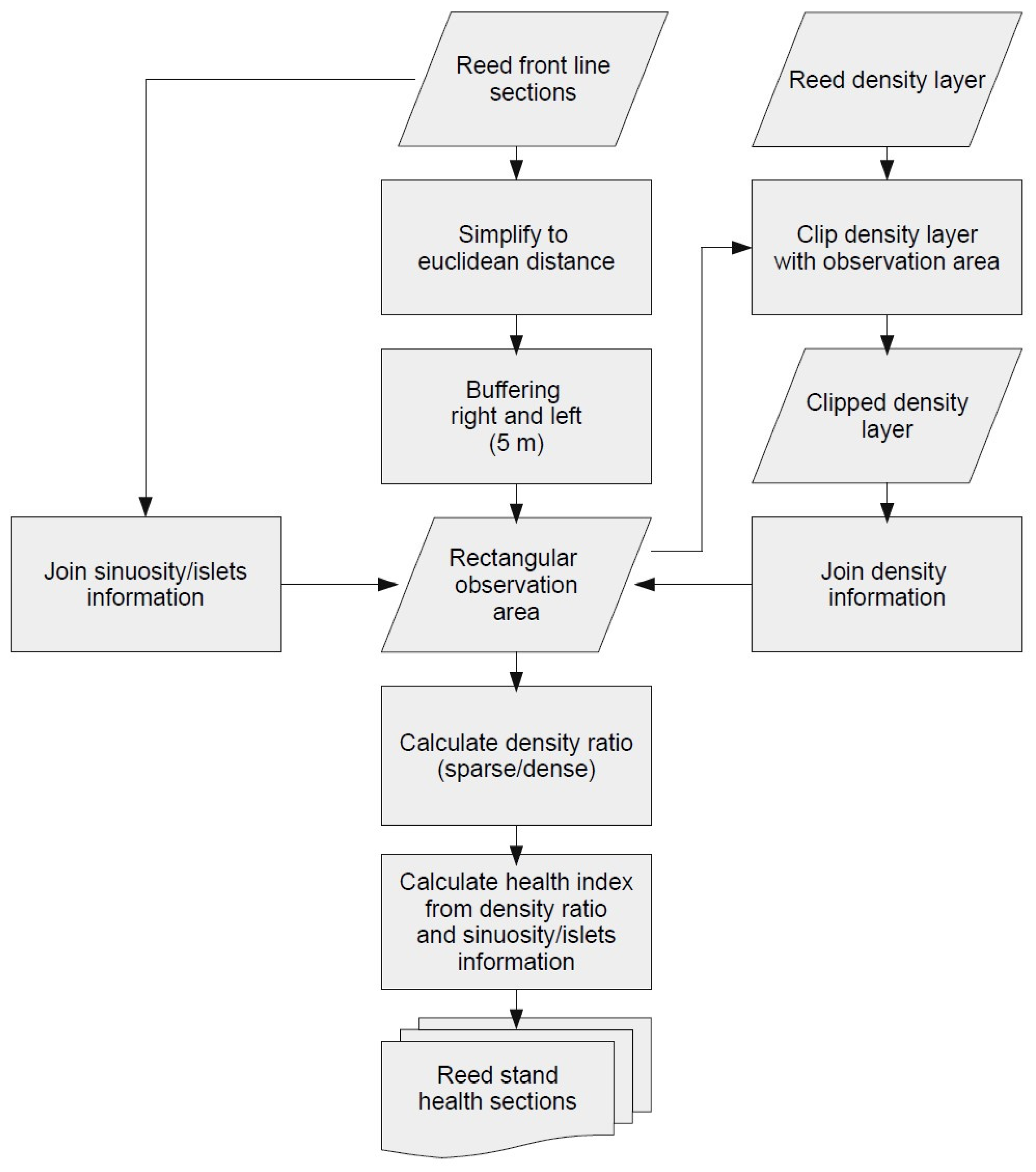

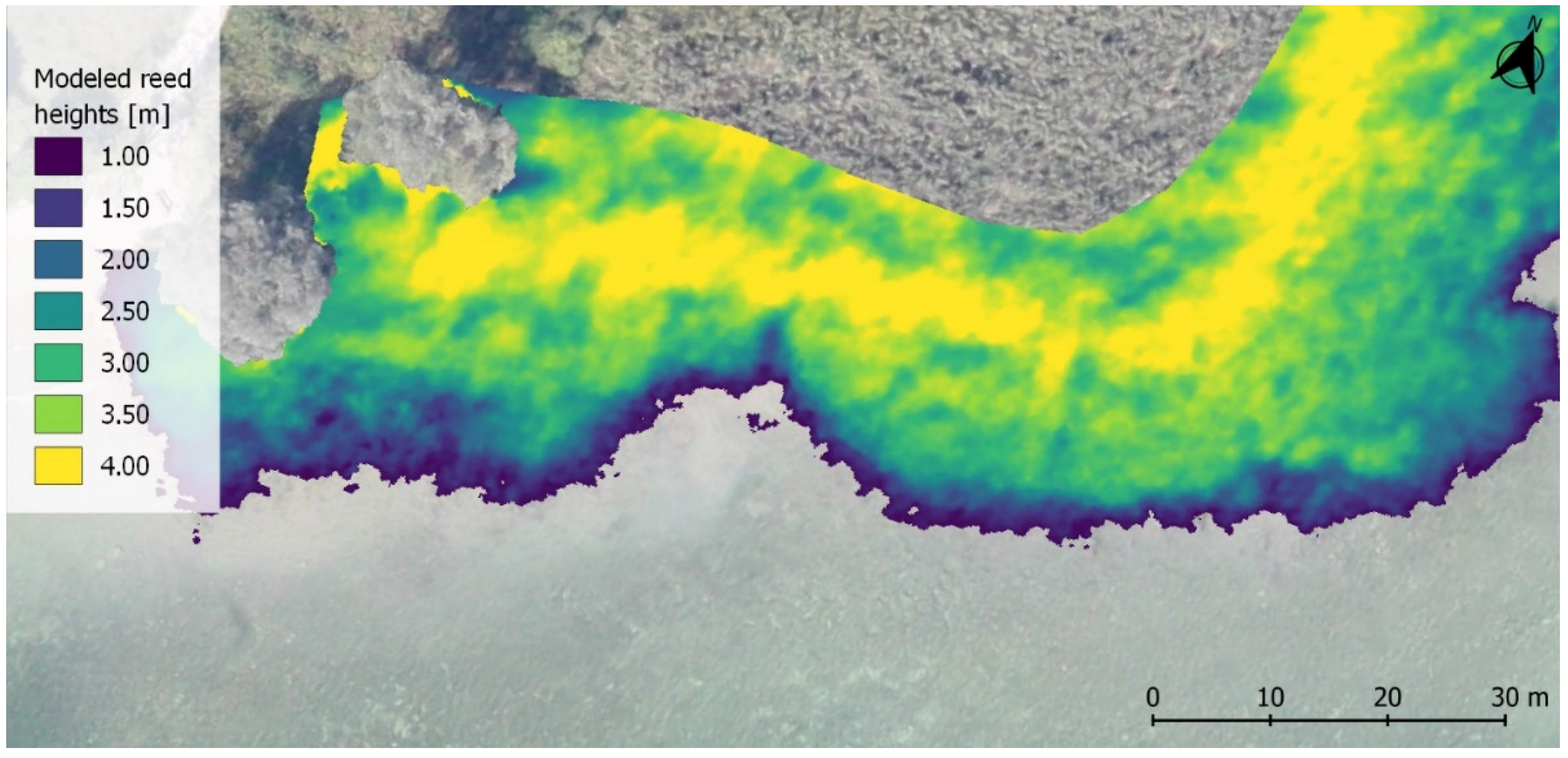
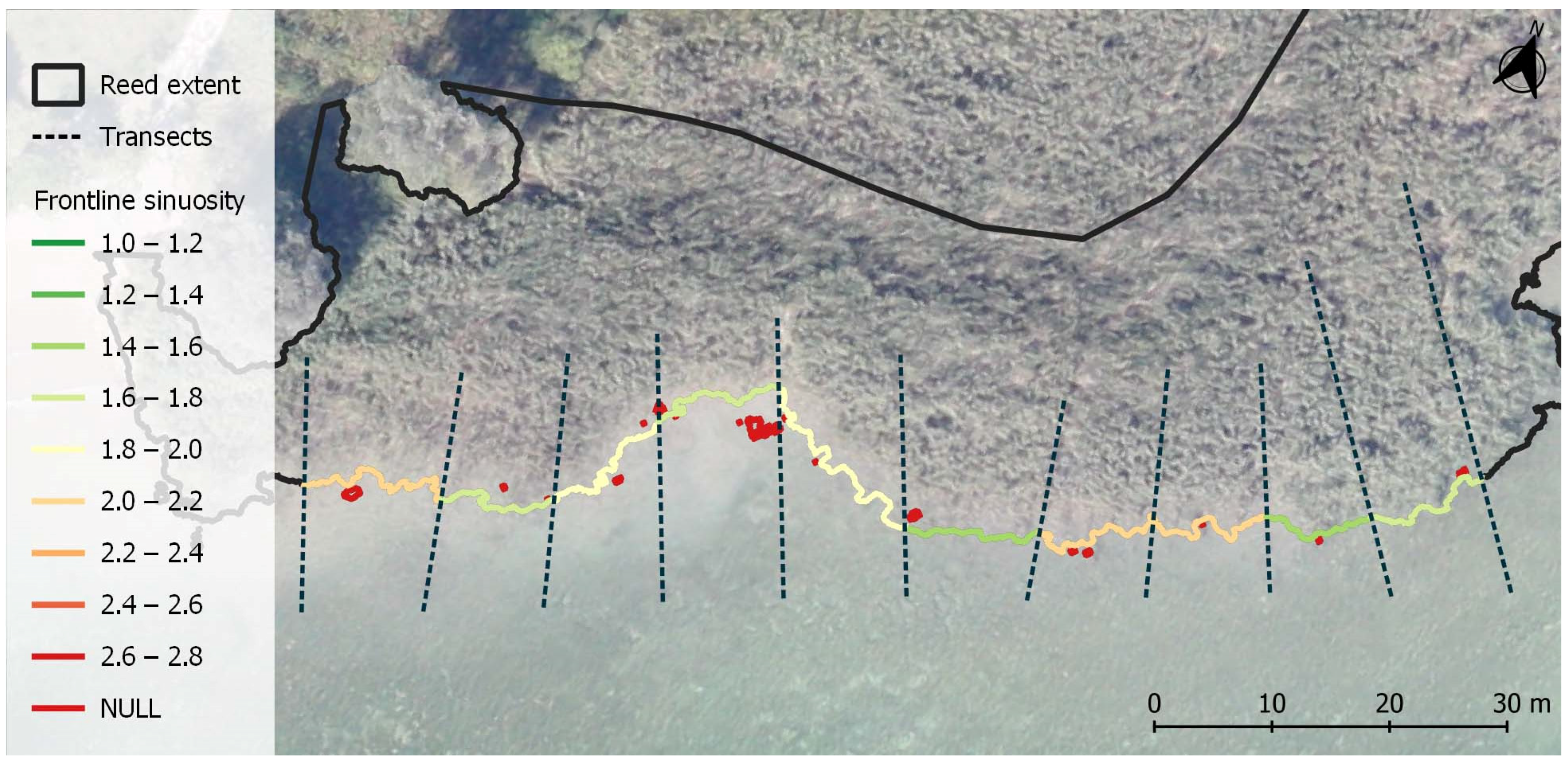
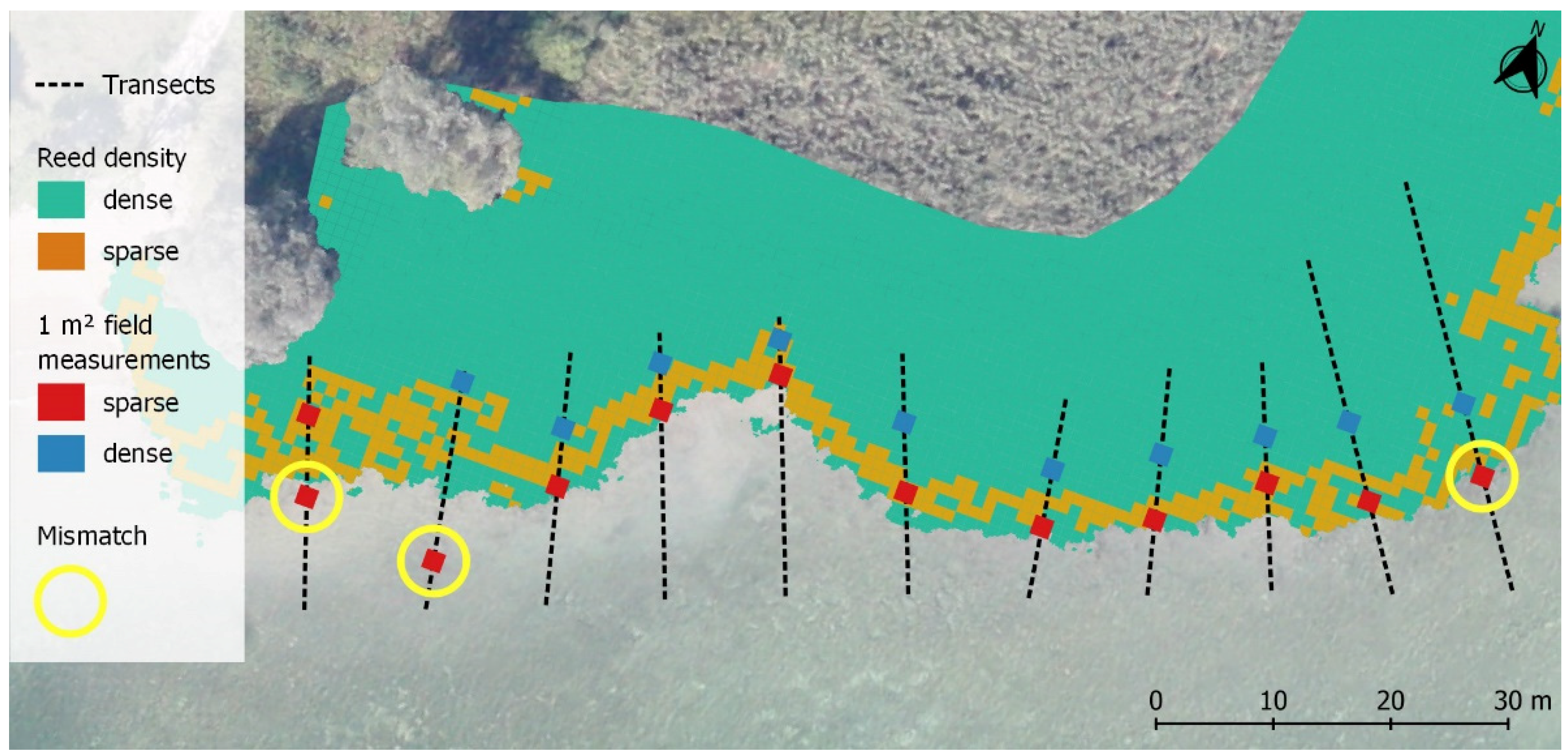

| AOI | RMSE (cm) | R2 | Date of Survey | RPs Horizontal DGPS Prec. (cm) |
|---|---|---|---|---|
| 1 | 44 | 0.71 | 9 September 2015 | 52.9 |
| 2 | 80 | 0.22 | 9 September 2015 | 45.5 |
| 3 | 46 | 0.74 | 8 September 2015 | 41.8 |
| 4 | 77 | 0.44 | 1 September 2015 | 44.3 |
| 5 | 39 | 0.75 | 1 September 2015 | 42.0 |
| 6 | 54 | 0.83 | 8 September 2015 | 41.4 |
| 7 | 69 | 0.39 | 15 September 2015 | 42.2 |
| 8 | 89 | 0.32 | 15 September 2015 | 44.0 |
| 9 | 39 | 0.83 | 11 September 2015 | 58.4 |
| 10 | 69 | 0.72 | 11 September 2015 | 43.0 |
| 11 | 68 | 0.75 | 15 September 2015 | 42.6 |
| 12 | 57 | 0.46 | 10 September 2015 | 41.9 |
| 13 | 104 | 0.51 | 9 September 2015 | 56.3 |
| 14 | 90 | 0.42 | 8 September 2015 | 55.0 |
| Total RMSE: 70 | Total R2: 0.60 | Total mean: 46.5 |
| Classified Data | Reference Data | ||||
|---|---|---|---|---|---|
| Aquatic reed | Water | Totals | User’s accuracy (%): | ||
| Aquatic reed | 1150 | 107 | 1257.00 | 91 | |
| Water | 208 | 1239 | 1447.00 | 86 | |
| Totals | 1358 | 1346 | 2704.00 | ||
| Producer’s accuracy (%): | 85 | 92 | |||
| Overall accuracy (%): | 88.35 | Kappa: | 0.77 | ||
| Classified Data | Reference Data | ||||
|---|---|---|---|---|---|
| Sparse reed | Dense reed | Water | Totals | User’s accuracy (%): | |
| Sparse reed | 61 | 11 | 14 | 86 | 71 |
| Dense reed | 29 | 76 | 15 | 120 | 63 |
| Water | 89 | 11 | 123 | 223 | 55 |
| Totals | 179 | 98 | 152 | 429 | |
| Producer’s accuracy (%): | 34 | 78 | 81 | ||
| Overall accuracy (%): | 60.61 | Kappa: | 0.41 | ||
| Classified Data | Reference Data | ||||
|---|---|---|---|---|---|
| Stressed reed | Healthy reed | Totals | User’s accuracy (%): | ||
| Stressed reed | 34 | 5 | 39 | 87 | |
| Healthy reed | 17 | 61 | 78 | 78 | |
| Totals | 51 | 66 | 117 | ||
| Producer’s accuracy (%): | 67 | 92 | |||
| Overall accuracy (%): | 81.20 | Kappa: | 0.61 | ||
Publisher’s Note: MDPI stays neutral with regard to jurisdictional claims in published maps and institutional affiliations. |
© 2022 by the authors. Licensee MDPI, Basel, Switzerland. This article is an open access article distributed under the terms and conditions of the Creative Commons Attribution (CC BY) license (https://creativecommons.org/licenses/by/4.0/).
Share and Cite
Baier, S.; Corti Meneses, N.; Geist, J.; Schneider, T. Assessment of Aquatic Reed Stands from Airborne Photogrammetric 3K Data. Remote Sens. 2022, 14, 337. https://doi.org/10.3390/rs14020337
Baier S, Corti Meneses N, Geist J, Schneider T. Assessment of Aquatic Reed Stands from Airborne Photogrammetric 3K Data. Remote Sensing. 2022; 14(2):337. https://doi.org/10.3390/rs14020337
Chicago/Turabian StyleBaier, Simon, Nicolás Corti Meneses, Juergen Geist, and Thomas Schneider. 2022. "Assessment of Aquatic Reed Stands from Airborne Photogrammetric 3K Data" Remote Sensing 14, no. 2: 337. https://doi.org/10.3390/rs14020337
APA StyleBaier, S., Corti Meneses, N., Geist, J., & Schneider, T. (2022). Assessment of Aquatic Reed Stands from Airborne Photogrammetric 3K Data. Remote Sensing, 14(2), 337. https://doi.org/10.3390/rs14020337







